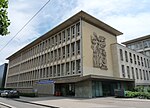Palais Universitaire, Strasbourg
1884 establishments in GermanyBuildings and structures by German architectsBuildings and structures completed in 1884Education in StrasbourgHistoricist architecture in France ... and 3 more
Monuments historiques of StrasbourgPlaster cast collectionsTourist attractions in Strasbourg

The Palais Universitaire in Strasbourg is a large, neo-Renaissance style building, constructed between 1879 and 1884 under the direction of the German architect Otto Warth. It was inaugurated in 1884 by Wilhelm I, Emperor of Germany. Through Avenue de la Liberté (former Kaiser-Wilhelm-Straße), it faces the equally monumental former imperial palace (Kaiserpalast). The building served for several decades as the centre of the new imperial University of Strasbourg. The old university transferred from the buildings that it had occupied for centuries at the Jean Sturm Gymnasium to the new ones located in the Neustadt.
Excerpt from the Wikipedia article Palais Universitaire, Strasbourg (License: CC BY-SA 3.0, Authors, Images).Palais Universitaire, Strasbourg
Place de l'Université, Strasbourg Quartier des XV
Geographical coordinates (GPS) Address External links Nearby Places Show on map
Geographical coordinates (GPS)
| Latitude | Longitude |
|---|---|
| N 48.5848 ° | E 7.7625 ° |
Address
Palais Universitaire
Place de l'Université
67000 Strasbourg, Quartier des XV
Grand Est, France
Open on Google Maps









